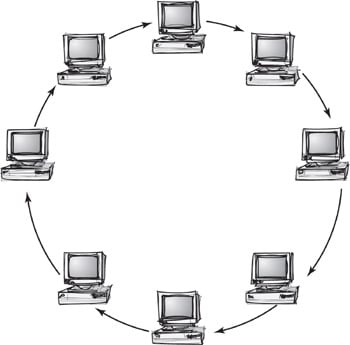BUS TOPOLOGY
Bus topology is a specific kind of network topology in which all of the various devices in the network are connected to a single cable or line. In general, the term refers to how various devices are set up in a network.
STAR TOPOLOGY
Alternatively referred to as a star network, star topology is one of the most common network setups. In this configuration, every node connects to a central network device, like a hub, switch, or computer. The central network device acts as a server and the peripheral devices act as clients.The picture to the right shows how this network setup gets its name, as it is shaped like a star.

RING TOPOLOGY
A ring topology is a network configuration in which device connections create a circular data path. Each networked device is connected to two others, like points on a circle. Together, devices in a ring topology are referred to as a ring network.

WHAT THE DIFFERENCE BETWEEN THIS THREE TOPOLOGY?
A Bus topology is a network topology in which all nodes connect to the network via a central cable, , called the bus. The bus acts as the shared communication medium that the devices are attached to. Any device that wants to communicate with other device on the network will send its data over the bus which will be send to all attached devices but the intended recipient will only process that packet. Thus bus topology is good and easy to setup for only a small number of devices, as devices and network utilization increases the performance issues and problems arise. If the bus is damaged then the whole network fails making bus topology a less preferred option.
In a Ring topology every device/node is connected to exactly two other nodes one on either side of it in closed loop fashion. All messages travel though the ring either in a clockwise direction or anti-clockwise direction. Ring topology is very rarely used today because they are expensive, difficult to install and manage. A failure in any single connection disrupts the ring topology thus also making ring topology a rare choice for network topologies.
Star topology is the most common topology and is the widely implemented. In a Star Topology every device is connected to a central device such as a switch. Star topology requires more cable as compared to other topologies but it mode robust as a failure in one cable will only disconnect the specific connected computer via that cable to the central device. The messages between systems will always flow via the central device and so if the central device fails the entire network will fail. Star topology is very easy install, manage and troubleshoot making it the most common topology in home and office networks.

No comments:
Post a Comment